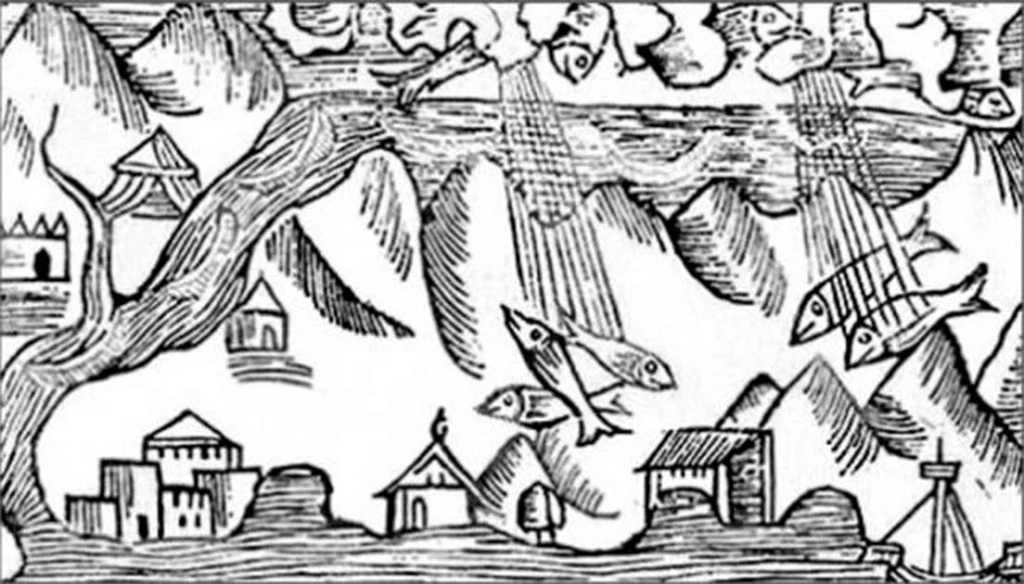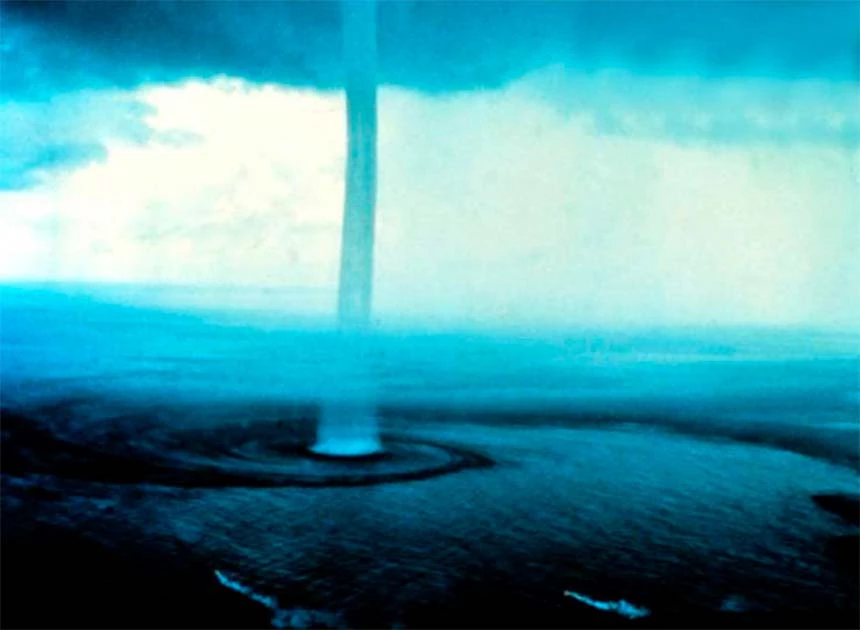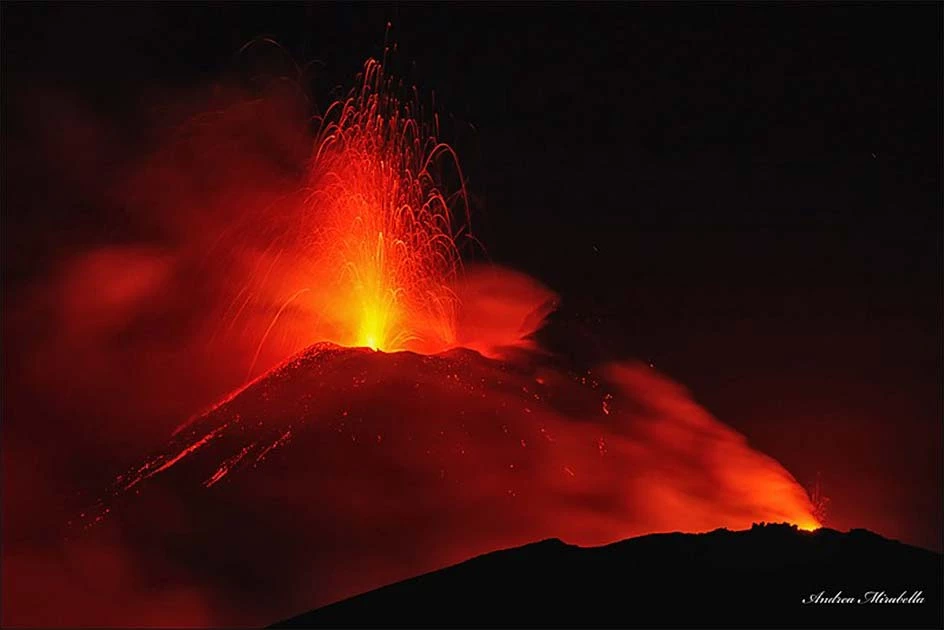Throughout our recorded history, there have been accounts of odd items raining down from the heavens. Animals such as fish and frogs, candy, aquatic creatures like jellyfish, beans, nuts, seeds, and a range of unusual and improbable objects have all been recorded falling from the sky, to general confusion.
A common explanation for these events suggests they are caused by powerful winds that lift items from the ground or bodies of water and toss them towards a town located several miles away. However, does this theory provide an adequate explanation for the reported showers of weighty stones known to cause structural damage to homes and result in injuries, and sometimes death, to humans and livestock?
A Historical Account of Objects Raining from the Sky
One of the earliest written accounts of objects “raining” down from the sky is from the Roman philosopher and naturalist, Pliny the Elder. In his writings from the 1st century A.D., he detailed storms of frogs and fish in what is now modern Italy.
Athenaeus, an ancient Greek rhetorician and grammarian, noted in his 3rd century A.D. work “The Deipnosophists” (Book VIII): “In Paeonia and Dardania it has, they say, before now rained frogs; and so great has been the number of these frogs that the houses and the roads have been full of them; and at first, for some days, the inhabitants, endeavoring to kill them, and shutting up their houses, endured the pest; but when they did no good, but found that all their vessels were filled with them, and the frogs were found to be boiled up and roasted with everything they ate, and when besides all this, they could not make use of any water, nor put their feet on the ground for the heaps of frogs that were everywhere, and were annoyed also by the smell of those that died, they fled the country.”

Many other peculiar instances have been reported over the centuries. These include a storm in Italy in 1840, which covered the ground with thousands of partially germinated seeds of the Judas Tree, a species native to Central Africa; a shower of sugar crystals in Lake County, California, in 1857; a rain of hazelnuts over Dublin, Ireland, in 1867; a fall of live pond mussels in Paderborn, Germany, in 1892; and jellyfish raining down in Bath, England, in 1894.
In what might have been one of the most intriguing such “rains,” a shower of 16th-century coins fell from the sky on June 16, 1940, in the Russian village of Meschera. Archaeologists theorized that a strong wind had uncovered and then picked up a buried cache that had been exposed by soil erosion, before dropping it back down.
E.W. Gudger, an ichthyologist at the American Museum of Natural History, was one of the first scientists to delve into the odd phenomenon of raining objects. He published a paper in the journal Natural History, titled “Rains of Fishes,” in the early 20th century, proposing four potential explanations for showers of marine species.
He theorized that certain “out-of-place” animal species might simply be in migration; that fish or other marine species were left stranded on land following overflow from ponds or streams; that estivating fish, awakened by heavy rains, had burrowed to the surface; and finally, that fish had been swept up from the ocean or lake by waterspouts or tornadoes and deposited many miles away on land.

The latter theory has garnered the most support. Jerry Dennis, in his book “It’s Raining Frogs and Fishes: Four Seasons of Natural Phenomena and Odd Oddities of the Sky,” asserts that theoretical calculations indicate that “golf ball-sized hail requires an updraft of more than 100 miles per hour, which would be more than powerful enough to loft small fish high into a thundercloud.”
Nevertheless, not all instances of falling objects can be easily accounted for by this explanation. Specifically, the phenomenon of raining stones, which has been reported to continue for multiple days or even weeks, often involving rocks of a size that seems too substantial to be transported great distances by wind.
The Mystery of Raining Stones
Much like the mystery of raining animals, the phenomenon of raining stones has a long historical record. One of the earliest accounts dates back to 1557, when Conrad Lycosthenes’s “Chronicles of Prodigies,” recounted a rain of stones resulting in the demise of both people and livestock.
In the medieval period, incidents of stones falling from the sky were ascribed to supernatural creatures or even demonic forces. In 1690, folklorist Robert Kirk suggested in his book “The Secret Commonwealth” that falling stones were the work of subterranean dwellers known as “invisible wights”—akin to goblins or brownies—which were said to throw the stones about, but never with the intent to cause harm. In 1698, a shower of stones from the sky was reported in New Hampshire, as documented in a pamphlet titled “Lithobolia, or the Stone-Throwing Devil.”
A highly publicized event of falling stones transpired in Harrisonville, Ohio, in October 1901. A small local newspaper, The Buffalo Express, reported that on Oct. 13, “a small boulder came crashing through the window of Zach Dye’s house.” No person was spotted nearby.
- Bizarre Rain – Pouring fish and frogs and crops
- The Ocean Ranger, the Mekhanik Tarasov and the Terrifying Power of Nature
Yet, this was just the start. In a few days, the entire town was purportedly besieged by stones and boulders falling from a clear sky. Baffled about the origin of these stones, the townspeople gathered all the men and boys of Harrisonville to ensure the phenomenon was not being perpetrated by a band of mischief-makers (the assumption being that women were incapable of such actions). However, the stones continued to fall. Several days later, the stone rain ceased as abruptly as it had begun.
Since that event, numerous other instances of stones falling from the sky have been documented, including in Sumatra (1903), Belgium (1913), France (1921), Australia (between 1946 and 1962), New Zealand (1963), New York (1973), and Arizona (1983).
Attempts to Explain the Phenomenon of Raining Stones
Scientists have openly acknowledged their lack of a conclusive explanation for the peculiar phenomenon of raining stones. Over time, numerous theories have been posited, ranging from poltergeist activity and supernatural beings to gangs of stone-throwers, volcanic activity, meteorites, tornadoes, and even divine punishment, as referenced in (Joshua 10:11): “the Lord cast down great stones from heaven upon them until Azekah, and they died.”
On November 23, 2013, a shower of small rocks descended upon Sicily, Italy. The event started following an eruption of Mount Etna, an active volcano that expelled pumice stones, dust, and ash into the sky. Vehicles ended up covered in small, sharp, black rocks. This instance clearly explains one occurrence of falling stones. However, many recorded events do not fit this scenario.

Another common hypothesis is that tornadoes or similar weather conditions might cause stones to fall. However, stone rains have been reported even in calm weather and in countries not typically affected by tornadoes. Moreover, tornadoes can only pick up debris and shoot it out in ballistic trajectories, they don’t cause debris to descend from the sky far from the initial location.
Some specialists have proposed that a meteorite entering the Earth’s atmosphere and breaking into smaller pieces might cause raining stones. However, such an event typically creates a sonic boom, a phenomenon not reported in any of these cases. Additionally, this explanation would struggle to account for instances where the phenomenon lasts for several days or even weeks.
As is often the case with unusual and unexplained phenomena, scientists and academics have typically been hesitant to scrutinize the subject in depth. A potential starting point might be examining the stones themselves to determine if they originate from the area where they fall or are from elsewhere, possibly even from outer space. Until such inquiries are made, we are left conjecturing about what might cause this curious phenomenon.
Top image: Raining Stones are not easily explained through our understanding of meteorology and wather. Source: Kien / Adobe Stock.